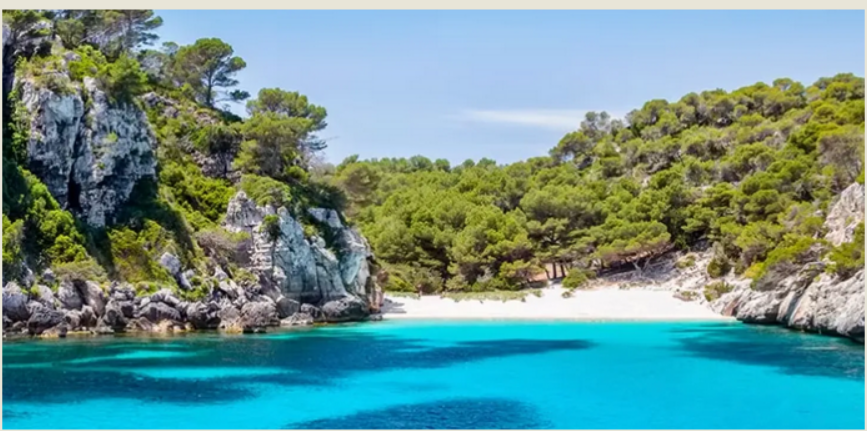Oh, The Places You'll Still Go!
Dear Wags,
The Travel Desk is here to shoo your troubles away. Yes, the world is swamped with godawful problems. We suggest that reading about them every three seconds is not, in fact, making them disappear. Put the antics of the House of Representatives aside for a moment. We are here with an escape hatch. The wonderful thing about travel —or reading about travel — is that it briefly liberates you from whatever hothouse you’ve locked yourself into. Earth is not defined only by its troubles but by beauty and possibility. Even on this planet’s worst day, you’ll find it more hospitable than Mars. Here are some destinations to put on your itinerary.
Sail away immediately.
Yours Ever,
Ibn Battuta
The Camí de Cavalls
We’ve heard there are places in the Balearic Islands where sweaty Anglo-Saxons jiggle all night to a throbbing beat. We’ve never been to them. Come only when those hordes retreat to their mossy northern lands, and give Ibiza a pass. Head to Menorca, which has the best beaches, ancient ruins, and quiet villages. If you need a nightclub you can find one, but it’s better to hike the Camí de Cavalls, a 116-mile path encircling the island. Built to link Menorca’s fortresses in the 1400s, the path can be navigated by foot, mountain bike, or horseback (hence the name). Menorca doesn’t lack places to stay at every price point, especially in the pretty island hub of Mahon. We love Alcaufar Vell in San Lluís, a magnificently maintained villa. The restaurant, Ses Cotxeries, makes a Mediterranean breakfast that will fuel you up for the day. —Jordi Farragut Mesquida
Epic wine country (Photo: Delaire Graff)
The Winelands
South Africa’s Western Cape is wine country, but the scenery is intoxicating enough. An hour west of Cape Town, the Mediterranean climate and a landscape of rugged mountains and lush river valleys is ideal for viticulture. Driving South Africa’s many wine routes will take you from the Atlantic coast to the high desert of the Little Karoo. Stellenbosch, the hub of wine tourism, is filled with great places to stay. If you want to luxuriate at the top end, try the eye-popping Delaire Graff Estate (if it’s too rich for your blood, just tour its art collection and gardens). Lovely Franschhoek, nestled at the foot of Mont Rochelle, is quieter. Biking between wineries is a big activity here, but if wine isn’t your thing, drinking in the landscape will keep you busy. The Panorama Route, above the magnificent Jonkershoek Valley, is one of the most spectacular hiking trails in South Africa. Imagine if Napa had antelopes and baboons. — Lucy Lurie
The Wilshire Walk
Walkin' in L.A., Walkin' in L.A., nobody walks in L.A. That old Missing Persons tune is wrong — plenty of people walk in L.A. Slowly but surely, Los Angeles is becoming like other world cities — meaning it’s feasible to get around without driving. We’re not saying the commute is always smooth, but what do you want for subway fare? In any case, walking L.A. will help you understand the place in a whole new way. The Los Angeles Conservancy offers a host of tours focused on the city’s neighborhoods and architecture. The intrepid should try trekking Wilshire Boulevard, which runs 15.8 miles from downtown Los Angeles to Santa Monica. Bring good shoes, plenty of water, and a hat — palm trees do not provide good shade. The route will take you from the Pacific to Beverly Hills, down the Miracle Mile, through Koreatown and MacArthur Park, and into the city’s reviving heart. The D Line metro is slated to open at Wilshire and La Cienega Boulevard in 2024 and reach the border of Brentwood in 2027. Until then, use Uber or Rapid buses as a backup west of the Wilshire and Western station. The Charlie Hotel in West Hollywood or The Georgian in Santa Monica are good places put up your feet. — Millicent L. Entwistle
More than the Beatles (Photo: VisitLiverpool).
Liverpool
Liverpool prides itself on being a diamond in the rough. Things are getting awfully polished — with shiny new buildings, art galleries, and repurposed wharves bringing visitors from around the world to its storied port. At Crosby Beach, take in Antony Gormley’s Another Place, which features 100 iron statues facing the sea, symbolizing the thousands of immigrants who traveled through Merseyside to reach America. The Tate Liverpool is part of bustling scene at the renovated Royal Albert Dock, and the food scene reflects the town’s international heritage. Try Röski for delicious farm-to-table fare from Wag Anton Piotrowski. Film lovers will like the movie-themed Arthouse Hotel in the trendy Ropewalks district, while the Malmaison Liverpool offers swank rooms, a great bar and views of the Mersey. All that, plus all those Beatles landmarks. – Priscilla White
The Alentejo
Portugal, like Iceland, found its way onto everyone’s list of places to go. That’s OK, because there is plenty of Portugal to around. The beaten path will take you to Lisbon, Porto, and the Algarve. The wide open Alentejo is the country’s rural hinterland, with sweeping vistas, untrammeled beaches, lonely castles, and villages of whitewashed houses set amid cork groves. Melides, on the Atlantic coast, has been discovered by the beautiful people, but it’s still rustic and unpretentious. If you want to splurge, Christian Laboutin’s Hotel Vermelho is a work of art, with just 13 rooms and Chef David Abreu’s restaurant, XTian. Still, the Alentejo isn’t a glitzy place — most hotels won’t break the bank. Ramble through the medieval hill towns of Monsaraz, Marvão, and Mértola, and hike the Southwest Alentejo and Vicentina Coast Natural Park, which protects miles of rugged coastline. You may feel as if you have Portugal entirely to yourself. — Amália Rodrigues
The Art Islands
Thousands of emerald islets are sprinkled in Japan’s Seto Inland Sea, which separates the larger islands of Honshu, Shikoku, and Kyushu. It’s a spectacular setting, but the real draw here is a small archipelago in Kagawa Prefecture that’s home to a smorgasbord of contemporary art. On Naoshima Island, the Benesse Art Site administers a host of galleries, including the Chichu Art Museum which displays paintings by Claude Monet and work by Walter de Maria and James Turrell, and the Lee Ufan Museum (both designed by architect Tadao Ando). Nearby Teshima Island hosts eight installations, including La forêt des murmures — an enormous grove hung with wind chimes. There are also exhibitions on several smaller islands. Benesse House Museum doubles as a serene hotel convenient to all the eye candy. The Terrace Restaurant serves locally sourced and artistically arranged cuisine. — Misaki Watari








